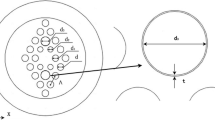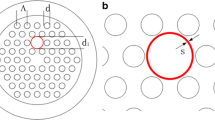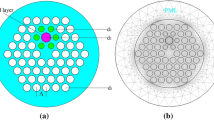Abstract
We propose a modified design for a photonic crystal fiber (PCF) filter based on surface plasmon resonance(SPR). The air holes are arrayed in rectangular lattices, while the size and the pitches of holes around the gold-coated holes are different. That can separate the x-polarization and y-polarization of second-order surface plasmon polariton (SPP). The resonance strength of the surface plasmon mode and import of structural parameters of the PCF on the filter characteristics are studied through using the finite element method (FEM). Numerical simulations demonstrate that the thickness of the gold layer, the gold-coated or gold-filled, and the asymmetry around the gold-coated holes have a great effect on the filter characteristics. It is certain to obtain a resonance strength as high as 873 and 771.5 dB/cm at the communication wavelength of 1050 and 1310 nm in x-polarization by adjusting the size and the place of the gold-coated holes, while the loss is extremely low in y-polarization.
Similar content being viewed by others
Avoid common mistakes on your manuscript.
Introduction
While the free electrons which exist in metal or semiconductor surface interact with electromagnetic wave, it can absorb the energy of electromagnetic wave, and then the surface plasmon resonance (SPR) occurs [1]. In recent years, the boosting development of SPR as an optical method for measuring the refractive index of very thin metal layers of material absorbed has attracted immense research interest worldwide [2]. With the advancement of the theory and the manufacturing process of the photonic crystal fiber (PCF), fiber optical SPR filter which is realized by metal-filled or metal-coated have became a hot research topic [3, 4]. In the metal-filled or metal-coated PCF, SPR can occur at the frequencies where the core-guided mode and the surface plasmon polariton (SPP) [5] can couple each other when the phase matching condition is met [6]. The SPP can form on the surface of the metal when metal is coated or filled into the PCF.
The combination of photonics and plasmonics is an emerging research area and has attracted growing interest all over the world. Kuhlmey et al. have theoretically analyzed metal-coated PCFs [7]. Zhang et al. [8] demonstrated an in fiber absorptive polarizer by selectively coating metal on the surface of holes for a triangular PCF, but the design of the PCF cannot meet the requirement of the polarization splitting PCF. Nagasaki et al. [9] have obtained large polarization extinction ration through selectively filling metal wires into three closely aligned air holes in the cladding. In the hexagonal fiber, resonances of the two orthogonal polarized are hard to be separate.
In this paper, a polarizing filter of PCF with two kinds of holes forming square lattice and the holes are selectively coated with metal of gold. We study the proposed PCF based on the full vector finite element method (FEM) [10] with perfectly matched layers [11]. Unlike other traditional polarizing filter of PCF [12], the high birefringence does not constitute the core of our design. We adjust the surface plasmon resonance point between the SPP modes and the core-guided modes by destroying the symmetry around the holes coated with gold. Numerical calculation results demonstrate that our proposed method can obtain good polarization filter at special wavelengths by changing some structural parameters of the fiber. The confinement loss at the wavelength of 1310 nm can be reached as high as 771.5 dB/cm, when the thickness of the metal film is 30 nm. We can also obtain the loss of 873 dB/cm at the wavelength of 1050 nm by adjusting the size and place of gold-coated holes, while other parameters are fixed. In addition, the resonance strength in x-polarized is far stronger than that in y-polarized at 1050 and 1310 nm, which is beneficial for the polarization filter.
Structure and Principle of Filter
Figure 1 shows the cross section of the proposed PCFs. The PCF has two kind of air holes forming square-lattice in the cladding. It consists of five layers of air holes in the x-polarized direction and four layer of air holes in y-polarized. The diameter of the bigger air holes is d 1=1.8μm, and the pitch between them is Λ1=2μm. The diameter of the smaller air holes is d 2=1.12μm with the pitch of Λ2=1.5μm between two adjacent small air holes. Moreover, the two red air holes are coated with metal of gold with the thickness of 30 nm, on whom the SPP mode can form, as is shown as Fig. 1a.Then we change the parameters of d and Λ for 0.74 μm and 1.7 μm as shown in Fig. 1b. The two red air holes are also coated with metal of gold with the thickness of 30 nm.
The chromatic dispersion of the background material which was pure sillica was calculated by the sellmeier equation [13]. Likewise, the material dispersion of gold is also characterized by the Drude-Lorentz model [14] and could be expressed as :
For we assume the metal as gold, so where ε ∞ =5.9673 is the permittivity of the gold, Δε=1.09 can be interpreted as a weighting factor, and ω is the angular frequency of guided light, ω D and γ D are the plasma frequency and damping frequency, ω D/2π=2113.6 THz, γ D/2π=15.92 THz. ΩL, and ΓL represent the frequency and the spectral width of the Lorentz oscillator. ΩL/2π=650.07 THz, ΓL/2π=104.86 THz.
The mode loss can be defined as:
where unit of the loss and wavelength is dB/cm and mm respectively; the Im[n e f f ] is the imaginary part of the effective refractive index [14].
In this paper, the perfectly matched layer (PML) [15] and a scattering boundary is used, while the phases of the SPPs modes and the core mode match. The energy in the core of the PCF can strongly couple to the surface plasmon of the metallic nanotubes. And the loss peaks are forming where the coupling occurs.
Numerical Result and Analysis
We first discuss the dispersion and loss of the gold-coated PCF shown in Fig. 1. We achieve the optimization results at the wavelength of 1050 and 1310 nm, respectively. Figure 2a shows the dependence of effective index on wavelength of x-polarized and y-polarized core modes. The solid, dashed, and dotted curves in the dispersion diagram correspond to the fundamental core mode of x-polarized, the fundamental core mode of y-polarized, and the SPP modes with different order (m=1,2) excited on the gold-coated layers covered on air-holes, respectively. The losses of the core modes are also shown in Fig. 2a. The couple properties are depicted obviously in Fig. 2. The first-order has much higher effective index than the core mode, as a result, it cannot couple to the core mode, as shown in Fig. 1a. While the second-order couples to the core mode. As we can see, the difference between the effective index of x-polarization and that of y-polarization is quite small. These two lines almost coincide with each other. So the birefringence is not high at all. Moreover, it is evidently that the reason of the difference between the x-pol resonance wavelength and the y-pol resonance wavelength is the apart of the second-order SPPs instead of the birefringence. The second-order SPPs are separated by a distance due to the high degree of asymmetry around the gold-coated holes. Finally, the separateness of the second-order SPPs result in the separateness of the loss peak. And the resonance strength between x-polarized and y-polarized have a sharp contrast as a result of the position of the gold wires. As shown in Fig. 1, the gold wires are placed in the x direction, and it finally leads to the larger loss in the x direction. Figure 2a shows the dispersion curves of x-polarized have a sharp spike around the wavelength of 1310 nm, where the coupling to the second-order SPP mode of x-polarized is as high as 771.5 dB/cm. While that of y-polarized is only 2.7 dB/cm. From Fig. 2b, we can obtain the loss of 873 dB/cm for the x-polarized, while that of y-polarized is 8.6 dB/cm. For the two structures, the resonance strength in x-polarized is much stronger than that in y-polarized. In Fig. 3, it is apparent that the energy of x-polarized core mode coupled into the surface of the metal nanotubes, while it is limited well in the core of y-polarized mode. That make this PCF a promising candidate for polarization filter devices.
It is proverbial that crosstalk (CT) is an important parameter of polarization filter, which determines the influence of unwanted polarization modes. The CT as a function of the fiber length can be defined as follows [16]:
where α 1 and α 2 are the losses of x-pol and y-pol modes respectively, and L is fiber length.
The CT as a function of the wavelength is shown in Fig. 4. It is evident that the crosstalk reach to the peak value in the phase matching points of 1310 and 1050 nm. The available optical bandwidth is defined as the wavelength range for the crosstalk better than 30 dB. As shown in Fig. 4a, the peak value and the bandwidth are increased as the fiber length changes from 200 to 1000 μm. The peak value of crosstalk can reach 668 dB, when the fiber length is 1000 μm. The bandwidth is 170 nm, when the fiber length is 200 μm. While the fiber length is larger than 300 μm, the right part of peak is higher than 30 dB totally. From Fig. 4b, we can clear see the bandwidth is 220 nm when the fiber length is 725 μm, while it is larger than 725 μm, the right part of peak is higher than 30 dB totally. When the fiber length is 1000 μm, the peak value can achieve 751 dB. Numerical simulation shows that the polarization filter characteristics of the designed PCF are good enough in the two communication bands.
Comparison of Gold-Coated and Gold-Filled for This PCF
In this section, we will study the difference between the gold-coated and the gold-filled in the air holes. We use two gold-filled holes instead of two gold-coated air holes with the same distribution of other air holes in the cladding. Figure 5 shows the loss of two PCFs, respectively. From Fig. 5, we can see that the resonance peaks of x-pol and y-pol directions are separated in both gold-coated and gold-filled PCF. In addition, the distance between them are almost the same. The difference between them is that the amplitude of the gold-coated PCF is much higher than that of the gold-filled PCF. Using gold-coated can actually help enhance the loss and improve the performance of the PCF-based polarization filters.
Different Thickness of the Gold Layer with Different Loss
In the former section, we have studied the difference between the gold-coated and the gold-filled. Now, let us explore the import of the thickness of the gold layer on the loss. As the surface plasmon waves are sensitive to the thickness of the gold layer, we have setted the thickness from 0.03 to 0.06 μm. The resonance peak moves to shorter wavelength and the resonance strength becomes smaller as the thickness of the gold-layer increase, as illustrated in Fig. 6. When the coating layer is too thick, the electric field has difficulty penetrating through [17]. Therefore, change the thickness of the gold layer can help to select the structure of the polarization filter.
The Importance of Symmetry Around the Gold-Coated Holes for This PCF
In this section, we will discuss the importance of symmetry around the gold-coated holes. Figure 7 presents import of different structures of PCF with only small air holes on the loss. We use small holes instead of big holes in the y-pol, as illustrated in the inset of Fig. 7. When there are two kinds of air holes in the cladding, the y-polarized peaks experiences a shift towards to the shorter wavelength and falls by a large amount, while the amplitude of x-pol increases. Accordingly, the x-pol and the y-pol are separated without high birefringence. Destroying the symmetry around the gold-coated holes can separate the second-order SPP mode by a large amount instead of the core modes. This approach can separate the resonance point of two orthogonal polarization states and improve the performance this PCF-based polarization filters.
Furthermore, the holes pitches and the size of holes have an effect on the filter characteristics. We have numerically simulated the effect and found that no matter the holes pitches or the size of holes can only change the position and the value of the resonance peaks in a small range (Fig. 7). Both the gold-coated and gold-filled for this PCF can separate the the resonance point of two orthogonal polarization states for same distance. But the gold-coated PCF can obtain higher loss. The thickness of the gold layer can also affect the resonance wavelength and resonance strength. As the coating layer becomes thicker, the resonance strength becomes weak. Last and most important, when destroying the symmetry around the gold-coated holes, even without high birefringence, we can separate the x-polarization and the y-polarization. These feature all we mentioned above are very beneficial for the single polarized filter to filter light in one direction.
Conclusion
We proposed a gold-coated PCF with two kinds of air holes based on SPP theoretically and detailedly investigated the influence of the thickness of gold layers, gold-coated or gold-filled, and the asymmetry around the gold-coated holes on the loss. The PCF we proposed, unlike the previous, need not high birefringence. Destroying the symmetry around the gold-coated holes can also transform the resonance point, thereby separate the resonance peaks in two orthogononal polarization states. Moreover, the resonance strength in x-pol is a hundred times higher than that in y-pol. At the wavelength of 1310 nm, the loss can reach as high as 771.5 dB/cm in x-pol while in y-pol, the loss is only 2.7 dB/cm. At the wavelength of 1050 nm, the loss can reach as high as 873 dB/cm in x-pol. We have also derived the dependence of crosstalk and the bandwidth of 1050 and 1310 nm. The peak value is 750 and 668 dB at 1050 and 1310 nm, and the wavebands with the crosstalk higher than 30 dB are extremely wide, while the fiber length is 1 μm. We provide a novel method for designing polarization filters, which is not rely on the birefringence of the fiber core. Numerical results show this method will be very meaningful for further studies in polarization filter applications and other fiber-based plasmonic devices.
References
Fano U (2012) The theory of anomalous diffraction gratings and of quasi-stationary waves on metallic surfaces (Sommerfeld’s waves). J Opt Soc 31(3):213–222
Slav́ik R, Homola J, Čtyroký J (1998) Miniaturization of fiber optic surface plasmon resonance sensor. Sensor Actuat B-Chem 51(1):311–315
Du Y, Li SG, Liu S (2011) Wavelength-selective characteristics of high birefringence photonic crystal fiber with Au nanowires selectively filled in the cladding air holes. Chin Phys B 21(9):094219
Xue JR, Li SG, Xiao YZ, Qin W, Xin XJ, Zhu XP (2013) Polarization filter characters of the gold-coated and the liquid filled photonic crystal fiber based on surface plasmon resonance. Opt Express 21 (11):13733–13740
Schmidt MA, Sempere LP, Tyagi HK, Poulton CG, Russell PSJ (2008) Waveguiding and plasmon resonances in two-dimensional photonic lattices of gold and silver nanowires. Phys Rev B 77(3):033417
Du Y, Li SG, Liu S, Zhu XP, Zhang XX (2012) Polarization splitting filter characteristics of Au-filled high-birefringence photonic crystal fiber. Appl Phys B 109(1):65–74
Kuhlmey BT, Pathmanandavel K, McPhedran RC (2006) Multipole analysis of photonic crystal fibers with coated inclusions. Opt Express 14(22):10851–10864
Zhang X, Wang R, Cox F, Kuhlmey B, Large M (2007) Selective coating of holes in microstructured optical fiber and its application to in-fiber absorptive polarizers. Opt Express 15(24):16270–16278
Nagasaki A, Saitoh K, Koshiba M (2011) Polarization characteristics of photonic crystal fibers selectively filled with metal wires into cladding air holes. Opt Express 19(4):3799–3808
Koshiba M (2002) Full-vector analysis of photonic crystal fibers using the finite element method. IEICE Trans Electon 85(4):881–888
Bermúdez A, Hervella-Nieto L, Prieto A, Rodríguez R (2008) Perfectly matched layers. Springer, Berlin Heidelberg, pp 167–196
Kakarantzas G, Ortigosa-Blanch A, Birks T, Russell PSJ, Farr L, Couny F, Mangan B (2003) Structural rocking filters in highly birefringent photonic crystal fiber. Opt Lett 28(3):158–160
Lee H, Schmidt M, Tyagi H, Sempere LP, Russell PSJ (2008) Polarization-dependent coupling to plasmon modes on submicron gold wire in photonic crystal fiber. Appl Phys B 93(11):111102
Vial A, Grimault AS, Macías D, Barchiesi D, Chapelle ML (2005) Improved analytical fit of gold dispersion: application to the modeling of extinction spectra with a finite-difference time-domain method. Phys Rev B 71(8):085416
Koshiba M, Tsuji Y (2000) Curvilinear hybrid edge/nodal elements with triangular shape for guided-wave problems. IEEE J Lightwave Technol 18(5):737–743
Chen w, Thoreson MD, Ishii S (2010) Ultra-thin ultra-smooth and low-loss silver films on a germanium wetting layer. Opt Express 18(5):5124–5134
Yu X, Zhang Y, Pan S, Shum P, Yan M, Leviatan Y, Li C (2010) A selectively coated photonic crystal fiber based surface plasmon resonance sensor. J Opt 12(1):015005
Acknowledgments
This work was supported by the National Natural Science Foundation of China (Grant No. 61178026 and 61475134) and the Nature Science Foundation of Hebei Province, China (Grant No. E2012203035). The authors wish to thank the anonymous reviewers for their valuable suggestions.
Author information
Authors and Affiliations
Corresponding author
Rights and permissions
About this article
Cite this article
Li, H., Li, S., Chen, H. et al. A Polarization Filter Based on Photonic Crystal Fiber with Asymmetry Around Gold-Coated Holes. Plasmonics 11, 103–108 (2016). https://doi.org/10.1007/s11468-015-0023-2
Received:
Accepted:
Published:
Issue Date:
DOI: https://doi.org/10.1007/s11468-015-0023-2











